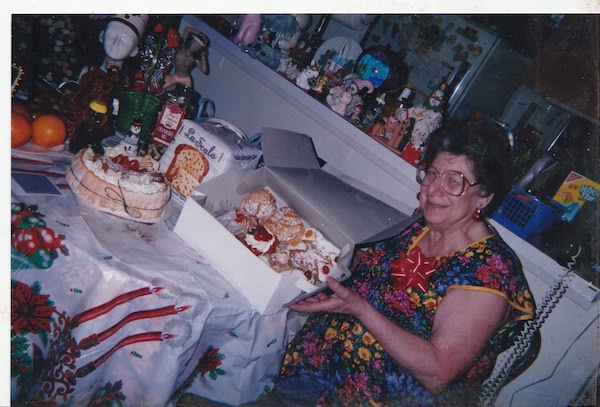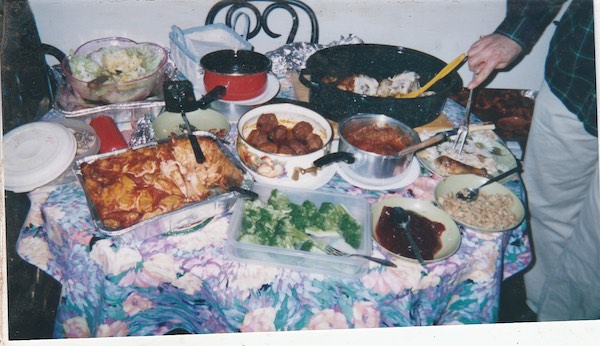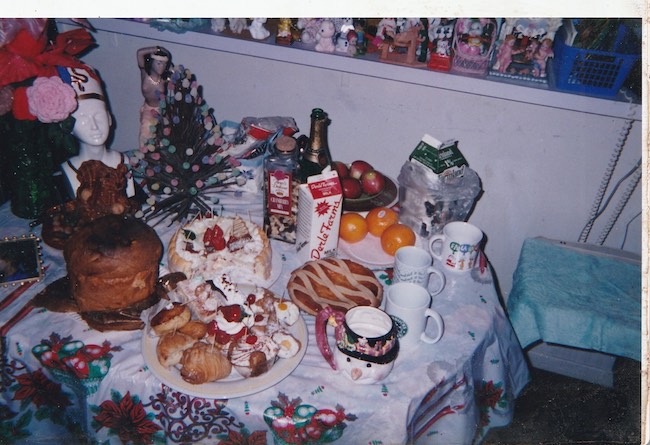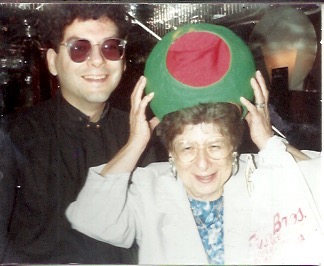
BY MICHAEL MUSTO | My mother, Anna Musto, was the best Italian-American cook, bar none. Anyone who disagrees…stai zitto!
When I was growing up in Bensonhurst, Brooklyn in the 1960s, mama Anna made all kinds of delicious things, like chicken and rice soup, sautéed fillet of sole, and escarole—or, more accurately, shcarole. (Italians always drop the vowels. They say scungeel! Manigott! Moozzarell! Those always sounded like curse words to me, but wow, did they taste good.)
She would also sometimes just serve banal things like Mrs. Paul’s fish sticks or a Swanson’s TV dinner, but those were yummy as well because she knew just how long to keep them in the oven and also which sauces and/or sides to accessorize them with.
But later on, when I was in my 30s and 40s and brought friends home to Brooklyn for the holidays, mama really turned it out to the point where a mere Christmas dinner became a three-act Italian pride parade. She would start with a huge bowl of “gravy meats”—homemade meatballs (mixed with a sprig of parmesan to give them a kick), Italian sausages, and bragioli, all swimming in homemade sauce; you know, gravy. And that was an appetizer!!!
Then she’d bring out a gigantic lasagna—or maybe some “manigott”—that could feed an army, and that was also just a starter! At this point, we were all ready to roll over and go to hog heaven, but then she would unveil the entrée—a lavish turkey or chicken or beef dish, or sometimes all of the above. And, naturally, there were side dishes galore, like candied yams, broccoli, peas with onions, and, of course, “shcarole” (though she usually employed that as a starter dish).

My mother especially welcomed my friend Bill Love because he always brought a healthy appetite with him. Mama would tell my other friends, “Don’t be shy! I don’t have to tell Bill not to be shy!” And my other friends included writer Lynn Yaeger, editor Mickey Boardman, DJ Anita Sarko, and designer Marc Jacobs and his then boyfriend Scotty Fritz. My parents met and welcomed them all—they became like their honorary extra children, an extended family of bohemian achievers. Jacobs even designed a line of shower curtains that he said was based on my mother’s bedspreads, though I wondered why he didn’t also do a line of bedspreads based on her shower curtains.
And then came dessert. Pudding, Jello, cakes, and pastries….plus my mother would brazenly crack open glazed donuts and plant some ice cream in the middle. She basically invented the cronut! I always said that if mom had marketed all her food ideas, she’d be as rich and famous as Mama Leone. But she wasn’t interested in mass marketing, only in catering to our intimate circle. And her concentrated bouts of cooking and cleaning made her feel useful, so she focused on all of that with gusto. Coming from a generation where so many women were limited to only being “housewives,” mama Anna performed her deeds like a demon, and I never saw her make a mistake at any of it—she was that dedicated.
And the cronut wasn’t the end of the food offerings, by the way. As each bloated person left to head back to Manhattan, my mother handed them a large shopping bag filled with leftovers: The gravy meats. The lasagna. The meat entrée. Sides. Desserts. And a Tupperware container filled with gravy! This doggie bag extraordinaire weighed a ton and a half, but my friends basically now had food for an entire week, not to mention the ultimate doorstop or paperweight.
Privately, I assured these lucky visitors that they were experiencing special occasions, not really what I grew up with—and a lot of the charm and merriment was trotted out for company too. When I was a kid, my parents were pretty much over each other and barely exchanged any words, except for occasional grunts and groans. (They didn’t make amends until much later.) I was one of the very few Italian-American only children in the world, and I came from the rare non verbal Italian-American household too. Ah, but the food!

Unfortunately, the lack of communication extended to the fact that my mother never taught me to cook. Maybe it was because boys back then weren’t supposed to do things like that or maybe she just wanted me to keep the old umbilical cord going. But I was not your typical boy, so I eventually taught myself how to make a lasagna via research, instincts and observational skills, and I came up with this:
—Boil the lasagna noodles in a big pot and splash in a little olive oil, to prevent them from sticking to each other. When they’re done—not too hard, not too soft—drain the pot, carefully take out the noodles, and lay them out on paper towels.
—Put a large tub of ricotta in a bowl. Crack an egg into it, sprinkle in a bit of pepper, and stir.
—Chop up mozzarella cheese into little cubes.
—In a big sauce pan, mix in two parts canned tomato sauce to one part canned tomato paste. Add a bit of water to make it smoother. Separately, fry tiny meatballs [if you like meat], as well as chopped onions and green peppers, in olive oil. When that’s done, drain it and put all that stuff into the sauce pan. Add chopped garlic, as well as salt, oregano, and any other seasonings you like. Simmer and stir to satisfaction.
—And then, in a large cooking tin, layer the gravy, then the noodles, then the ricotta cheese, and then the diced “moozzarell.” And then repeat, again and again, till you almost reach the top of the tin. It’s all about the layers. Then bake the lasagna at 400 degrees for about 45 minutes. Make sure it’s firm—not runny—and then take it out and let it sit for 15 minutes. Sprinkle some grated parmesan on top and maybe even some extra gravy (heated, of course) and enjoy.
Once in the ‘90s, I made just such a lasagna, which I brought to a friend’s house because she was having a birthday party for her husband. I also brought my mother along, since she knew the couple through me. Everyone was raving about my lasagna, which had come out just about perfect. “Michael’s lasagna is wonderful, Mrs. Musto,” I overheard someone say. “Aren’t you going to have a piece?” My mother genteelly replied, “Yuck!”
That was rather ungracious, but maybe she had wrongly assumed that I used gravy out of a jar, the thought of which always made her retch. (Me, too! I would never do that.) Or maybe she was simply channeling Stephen Sondheim’s mother, lol. Whatever the case, I knew that I could never rival her in the kitchen, nor would I try. To this day, I have a hard time enjoying an Italian restaurant because I know that, as good as it will be, it won’t reach the heights of my mother’s cooking. It won’t have the knowhow, the attention to detail, the desire to please. So, grazie, ma. Thank you for the gravy meats and the shcarole.

—END—

Michael Musto is a columnist, pop cultural and political pundit, NYC nightlife chronicler, author, and the go-to gossip responsible for the long-running (1984-2013) Village Voice column, “La Dolce Musto.” His work appears on this website as well as Queerty.com and thedailybeast.com, and he is writing for the new Village Voice, which made its debut in April of 2021. Follow Musto on Instagram, via @michaelmusto.
Chelsea Community News is an independent, hyperlocal news, arts, events, info, and opinion website made possible with the help of our awesome advertisers and the support of our readers. Our Promise: Never a paywall, no pop-up ads, all content is FREE. With that in mind, if circumstances allow, please consider taking part in our GoFundMe campaign (click here). To make a direct donation, give feedback, send a Letter to the Editor, or contact our founder/editor, email Scott Stiffler via scott@chelseacommunitynews.com.
To join our subscriber list, click here. It’s a free service providing regular (weekly, at least) Enewsletters containing links to recently published content. Subscribers also will be sent email with “Sponsored Content” in the subject line. That means it’s an exclusive message from one of our advertisers, whose support, like yours, allows us to offer all content free of charge.

You must be logged in to post a comment Login